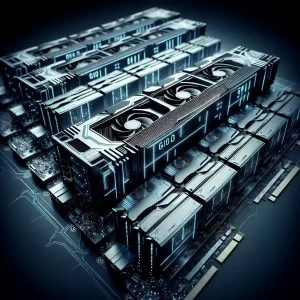Nvidia’s China‑Specific Blackwell Chip: What It Is, Why It Matters, and How to Think About It

Nvidia is reportedly building a new Blackwell‑architecture AI chip specifically for China that could outperform the H20 — the China‑compliant GPU it currently sells there. Multiple outlets, citing sources close to the company and to regulatory discussions, say the new chip (internally called the B30A) uses a single‑die Blackwell design with high‑bandwidth memory and NVLink and may deliver roughly half the raw compute of Nvidia’s flagship dual‑die B300 card. Nvidia and U.S. officials stress any sale would depend on export approvals. Still, the news matters: it’s a technical move, a commercial maneuver and a geopolitical chess play all at once.
This article explains what’s being reported, why the details matter, what tradeoffs Nvidia faces, and how customers, competitors and policymakers should think about the situation.
What’s being built (and how it differs from what China already has)
- Name and architecture: The new China‑targeted chip is reportedly a Blackwell‑based part, tentatively named B30A. Blackwell is Nvidia’s latest architecture and powers the company’s highest‑end accelerators.
- Design choice: B30A is said to use a single‑die design. That means the chip’s compute elements live on one continuous piece of silicon rather than two separate dies bridged together. Single‑die usually simplifies manufacturing and lowers cost, but it reduces the total number of compute units compared with a dual‑die flagship like the B300.
- Performance posture: Sources estimate the B30A will offer about half the raw computing power of the B300, yet still surpass the H20 — the China‑specific Hopper‑generation part Nvidia rebuilt to comply with earlier export controls.
- Memory and interconnects: Like the H20, the B30A reportedly includes high‑bandwidth memory (HBM) and NVLink for fast data movement between processors. Those features keep the chip capable for large model training and multi‑GPU workloads, even if peak TFLOPS lag behind top global products.
- Timeline and variants: Reporters say Nvidia hopes to ship samples to Chinese clients for testing potentially as soon as next month. Separately, Nvidia is preparing another China product (the RTX6000D) aimed primarily at inference and priced below the H20; it uses conventional GDDR memory and sits just under U.S. bandwidth thresholds.
Why Nvidia would make a China‑only Blackwell part
Think of Nvidia’s China strategy like a dance between two partners: the company needs to keep selling into a huge market, but it has to stay in step with U.S. export rules and political pressure. China generated about 13% of Nvidia’s revenue in the latest year, so cutting off that market creates both commercial and ecosystem risks.
- Retain developer ecosystem: Nvidia’s software stack (CUDA, cuDNN and other tools) locks a lot of AI development into its platform. Selling China‑compliant Blackwell chips helps keep Chinese developers tied to Nvidia software rather than shifting fully to local solutions (for example, Huawei).
- Competitive defense: Chinese chipmakers have closed gaps in raw compute. By offering a Blackwell‑based China product that outperforms the H20, Nvidia can blunt some momentum from local rivals while still respecting export limits.
- Regulatory hedging: Designing multiple China‑specific SKUs — one more capable (B30A) and one tuned for inference (RTX6000D) — gives Nvidia flexibility. If Washington allows a scaled‑down Blackwell, Nvidia can move quickly. If regulators restrict sales, Nvidia can still offer lower‑spec parts that fall under thresholds.
Table — quick technical and strategic comparison
| Product | Architecture | Die design | Memory | Relative performance (reported) | Primary role |
|---|---|---|---|---|---|
| B300 (flagship) | Blackwell | Dual‑die | HBM | Top tier (reference) | Flagship training accelerator |
| B30A (reported China part) | Blackwell | Single‑die | HBM | ~50% of B300; >H20 | China‑targeted training/workload testing |
| H20 (China current) | Hopper | N/A (China‑compliant) | HBM | Lower than B30A (reportedly) | Existing China training accelerator |
| RTX6000D (reported China inference SKU) | Blackwell | Simpler design | GDDR | Weaker than H20; below regulatory thresholds | Inference and lower‑cost deployments |
(Notes: figures and designations drawn from multiple reports; Nvidia has not confirmed detailed specs. “Relative performance” is reported/estimated, not measured.)
Regulatory tension: approvals are not guaranteed
U.S. authorities have been cautious about exporting advanced AI compute to China. The H20 itself was designed to satisfy 2023 export restrictions and faced a temporary sales pause earlier this year. The new political context complicates things further:
- Executive-level negotiations: President Trump has suggested he might allow scaled‑down Blackwell chips in China, even proposing revenue sharing with the U.S. government (reported deals included a 15% cut of some sales). That political green light is not a final regulatory approval; Commerce and other agencies must still weigh national security risks.
- Legislative wariness: Bipartisan lawmakers remain anxious that even scaled‑down chips could accelerate China’s AI capabilities in sensitive sectors. Any approval will likely come with strict conditions and technical thresholds.
- Compliance engineering: Nvidia will design variants to meet explicit bandwidth and capability thresholds. The RTX6000D example shows how engineering can target the precise line of permissibility — memory bandwidth of 1,398 GB/s was reported to sit just below a 1.4 TB/s cap.
What this means for Chinese customers and developers
- Short term: If approved, the B30A could provide Chinese AI labs more training muscle than the H20, reducing pressure to migrate off Nvidia’s software ecosystem. Sampling to clients helps developers test and adapt models to Blackwell capabilities.
- Longer term: Continued access to newer Nvidia silicon — even scaled variants — may accelerate large model experimentation in China, pushing both software sophistication and infrastructure scale. That, in turn, raises competitive pressure on local chip designers to close the ecosystem and software gaps.
Risks and tradeoffs for Nvidia
- Political exposure: Appearing to enable advanced AI development in China invites scrutiny in Washington and risk of future tighter controls.
- Brand and security narratives: Chinese state media and regulators have raised questions about security risks in foreign chips. Nvidia disputes those claims, but perception can affect adoption.
- Supply and manufacturing complexity: Multiple region‑specific SKUs add manufacturing overhead and segmentation that can complicate logistics and margins.
How competitors and policymakers should read the move
- Competitors: AMD, Intel and Chinese firms get a signal: Nvidia values China market share enough to design variants, so expect tailored product strategies and faster iteration from everyone. Companies should prioritize both silicon performance and software compatibility.
- Policymakers: If the U.S. permits scaled‑down Blackwell chips, clear, technology‑specific thresholds matter. Policymakers should focus less on blunt bans and more on well‑defined technical ceilings, end‑use restrictions and monitoring mechanisms.
- Researchers and practitioners: Teams in China and abroad should plan for heterogeneous access to hardware. Software portability, optimization for constrained memory bandwidths and modular training pipelines will reduce friction if hardware capabilities differ across regions.
Analogies to keep the picture clear
- Think of Nvidia’s product lineup like a vehicle fleet. The B300 is a high‑powered sports car; the H20 is a sturdy sedan tuned to local rules; the B30A is a turbocharged sedan that borrows some sports‑car tech but still stays within local speed limits. Each vehicle serves different roads and regulations.
- Consider export controls as a traffic light system: green means open highway, red bars access, and amber forces redesign — that’s what China‑specific chips represent: amber engineering that lets vehicles continue moving, just at restricted speeds.
Practical guidance for stakeholders
- For Chinese AI teams: Test code on multiple hardware profiles and prioritize performance portability. If B30A samples arrive, benchmark end‑to‑end workflows (memory‑bound kernels, multi‑GPU scaling, NVLink benefits) rather than just raw TFLOPS.
- For enterprise buyers globally: Factor potential region‑specific divergence into long‑term procurement and licensing strategies. Ensure software frameworks remain flexible so models can transfer between different Nvidia SKUs and alternative silicon.
- For investors and competitors: Watch approvals, revenue‑share deals and any technical thresholds announced by regulators. Sales in China will affect market share, revenue outlook and how quickly Chinese firms can scale large‑model training.
- For policymakers: Define technical thresholds clearly and couple them with auditing and end‑use checks. Technical specificity reduces ambiguity and allows firms to design compliant products without guessing.
Bottom line
Nvidia’s reported plan to build a China‑specific Blackwell chip that outperforms the H20 but sits below flagship B300 performance reflects a deliberate balancing act: keep Chinese customers on Nvidia’s software and hardware path while trying to satisfy tough U.S. export constraints. The technical choices — single‑die Blackwell, HBM and NVLink — aim to deliver useful training capability without breaching regulatory red lines.





